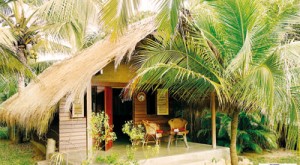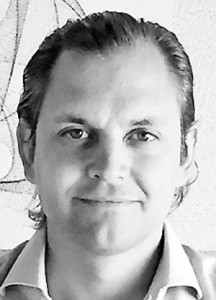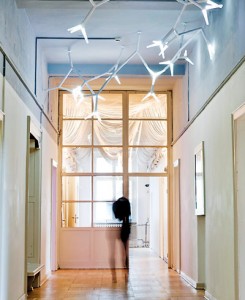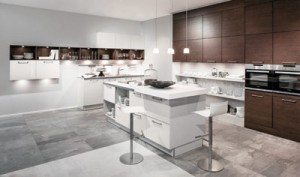Exploring interiors
The Sri Lanka Design Festival organised by the Academy of Design which begins on Friday, November 27 will once again see the return of the interior design exhibition at the SLECC that aims to shed light on the current design scope in the country, while encouraging young designers to explore possibilities in the field.
The exhibition will be open to the public and will be complemented by a knowledge sharing forum involving global speakers and architects.
The Sunday Times spoke to Daniel Becker and John Balmond, who are scheduled to speak at the forum sessions and Kasun Rupesinghe, a young interior designer hoping to make his own mark in the field.
John Balmond heads the Balmond Studio in Sri Lanka. The son of internationally renowned Sri Lankan-British architect and designer Cecil Balmond, he came to Sri Lanka from London in 2009 to build Palagama Beach, a resort in Kalpitiya.
“My father and I were both taken by the way local villagers built their houses with iluk and other natural materials,” he explains. Palagama is an extension of Balmond’s “love affair with interiors designed from sustainable materials”.

John Balmond and above Palagama Beach
Balmond makes special mention of using rustic, traditional material for contemporary design-or “with a modern twist”. While Balmond Studios may not necessarily use such materials in all their projects, “it’s important for us to design in a way so that both the inside and outside are in sync with the surroundings,” he says.
Balmond believes that an important tenet of interior design is to design such that a space remains exciting and fresh even after a period of 5-10 years.
Thus “modernity for the sake of modernity” is unnecessary, he says, because interiors date quickly. At the London Balmond Studios, on-going research aims to identify patterns in interior design; science plays a part, but aesthetically too interior design must fulfil its role-and “it must feel right”, he reiterates.
“Sri Lanka has the talent,” says Balmond. “What we need are more interior designers who are not afraid to go into the unknown.” Events like SLDF play a significant role in this, he notes, adding “we’re very happy to be involved.” Balmond will speak at the Interior Design Forum (Balmond Studio will exhibit).
An interior designer with Fine Furniture in Rajagiriya, Kasun Rupesinghe’s company will stage an exciting exhibit at SLDF, and as Operations Manager, Kasun plays a significant role in its implementation.
The designer graduated with a degree in interior design from Northumbria University-“I initially wanted to become an architect,” he says.
“Interior design wasn’t very popular as a career option in 2007 when I started but this course sounded very interesting to me so I took it on.”
Almost a decade later he’s very pleased he did so. “To me the highlight of being an interior designer is working with clients to design a living space that’s very personal, as something they’ll occupy for some time,” he says.
“My boss, Martin Klement, has given me the opportunity to explore interior design from a very functional, practical viewpoint. We talk a lot about aesthetics but it’s also important to remember that spaces need to serve a purpose, and be durable.”
German industrial designer Daniel Becker will visit Sri Lanka to speak at SLDF on the ‘Sparks’ modular lighting system, one of his most successful pieces to date-a sculptural piece of lighting adaptable to almost every architectural situation.
Becker specializes in industrial design. “I had the abstract dream of becoming an inventor as a child,” he tells us via email. “I have always been fascinated by shapes, materials and construction.
Later on I realized that there is actually a profession which allows me to create things in a creative way: industrial design.”
Asked why he decided to establish his own practice almost immediately after graduating from Braunschweig University, he says: “the good thing is that you learn best (and very quickly) by your own mistakes, the bad thing is that it’s really hard to avoid mistakes and some of them might turn out costly, too.
So I’m not sure if I would recommend doing the same thing to others. On the positive side, however, the experience is direct, your learning curve is very fast and you find individual solutions which you might not have learned in an agency or similar.”
He draws inspiration from fine art (sculpture in particular), music, film and travel. Becker seeks a constant visual input, perhaps owing to a preference for working with lights and lamps.

Kasun Rupasinghe (top) and one of his company’s model kitchens
“I guess what I love most about it is the fact that you have relatively few limits in lighting products,” he says. “It’s as close as you can get to fine art sculptures in industrial design, as you’re really able to create abstract shapes.
When designing a chair or a sofa you have way more rules and limits to consider, for example. The ergonomic part is essential, you have certain measures that you need to take care of, otherwise you can’t sit on it and it’s not a chair anymore. This is less the case in many areas of lighting.”
At SLDF Becker will speak about finding individual, creative ways to resolve design tasks. “An event like SLDF is a great opportunity to present different approaches from all over the world to the people, to share individual thoughts and offer new perspectives on design,” he shares.
“I’m very much looking forward to the experience and discussions!” Becker will speak at the Interior Designer Forum and Design Katha.

Interior Design Exhibition: November 26-29 ( 9 a.m.- 6 p.m.) at SLECC
Interior Trend Exhibition: November 27-29 (9 a.m.- 5 p.m.) at SLECC
Design Katha: November 29 (9 a.m.) at SLECC
Interior Design Forum: November 27 (1-3 p.m.) at SLECC


